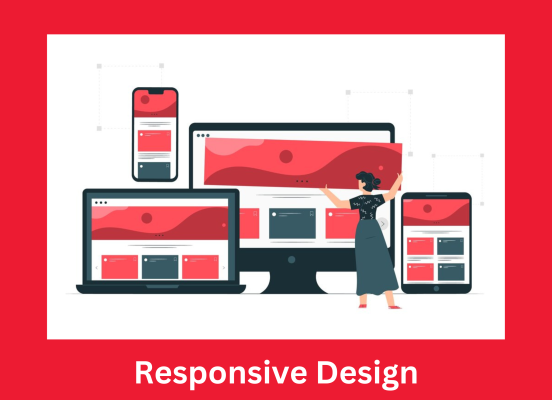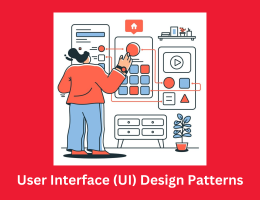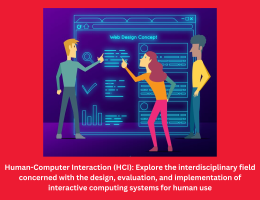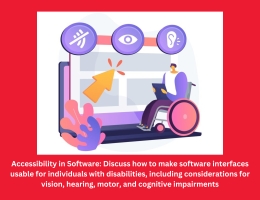
Responsive Design: Explore techniques and best practices for designing interfaces that adapt seamlessly to different devices and screen sizes
- By admin --
- Sunday, 10 Mar, 2024
A key factor of cutting-edge internet improvement is responsive design, which makes positive that apps and web sites alter smoothly to different screen sizes and devices. It is imperative that we understand how important responsive design is these days because it guarantees an intrinsically consistent and user-friendly clearness for all devices including desktop PCs, smart TVs, smartphones, tablets which are some of the key items used worldwide.
At its core, responsive design aims to provide the optimal viewing experience across all platforms. Bendy grids are used to dynamically change how records are displayed and arranged according to a user's device specifications. To achieve this, flexible layouts as well as media queries are utilized. In general, today’s flexible design principles make it possible for developers to come up with interfaces that fit smoothly into all screen sizes, resolutions and orientations so as to allow users access information conveniently.
The usage of flexible grids is one of the fundamental methods of responsive design. Developers determine the size and site of objects inside the interface the use of relative devices, such percentages or ems, rather than constant pixel-primarily based layouts. This enables data to adapt flexibility to different screen sizes, keeping shape and legibility on various devices. By using a grid-based system, developers can make a single interface structure for their applications, ensuring that every viewport size maintains unity and alignment across them.
Responsive format makes use of fluid layouts similarly to flexible grids to support exceptional display display sizes and difficulty ratios. Developers describe measurements the use of chances or other relative devices in preference to organising constant widths for columns and containers, allowing content to resize or cut back in keeping with the available screen real estate. Because of this fluid method, interfaces can dynamically adjust to varying viewport widths, making sure that facts will always be readable and aesthetically attractive on any tool.
Another critical detail of responsive design is media queries, which allow programmers apply specific styles consistent with the person's device specifications. Developers may also specify breakpoints at which the interface's layout and layout will modify to fit various display sizes through utilizing CSS media queries. In order to make each user's experience on every device the best it can be, one website might choose, for instance, to possess layouts that are great for desktop, tablet and phone displays, with matching styles done using media queries.
Responsive layout now not handiest modifies layout and style but moreover optimises media belongings and photographs for numerous display sizes and tool competencies. This may contain the use of techniques like responsive pictures or CSS sprites to lessen net website online load times and bandwidth consumption, or it may involve offering more than one photo sizes or codecs depending on the consumer's tool. Without sacrificing speed or beauty of appearance, developers can optimize media assets for different devices to ensure that customers have the best experience possible.
Taking into account contact interactions on mobile gadgets is a essential component of responsive layout. Touchscreen navigation is already commonplace because to the developing popularity of smartphones and tablets, therefore builders need to create interfaces which might be optimised for touch enter. This might entail making interactive gadgets extra broadly spaced aside, making tap objectives larger, and minimising hover-established interactions that are not possible for touchscreens. Through the prioritisation of touch-fine layout styles, developers may additionally produce cell interfaces which is probably consumer-pleasant and intuitive.
In order to permit human beings with disabilities or impairments use consumer interfaces, accessibility is a vital part of responsive layout. It is possible to include features such as resizable text, high contrast alternatives and keyboard navigation aid for visually impaired, motor impaired, or those with cognitive disabilities. By adhering to accessibility guidelines and recommendations, developers may also create inclusive user interfaces that suit a diverse clientele, irrespective of their abilities or use of assistive technology.
Iterative testing and refinement are essential aspects of responsive design, allowing developers to identify and address issues across different devices and screen sizes. Through the usage of equipment like browser developer tools and tool emulators, developers can take a look at interfaces throughout a number gadgets and discover layout inconsistencies, overall performance bottlenecks, and usefulness problems which could arise in numerous scenarios. By the use of this approach, software program engineers may additionally maintain getting higher at what they do at the same time as making certain that person interfaces function flawlessly throughout a number of devices.
Responsive layout is important to cutting-edge internet development because it allows person interfaces to adapt to a couple of display sizes and devices. Developers rent media queries, responsive layouts, bendy grids, and touch-pleasant design styles to supply aesthetically fascinating, intuitive, and device-wide consumer experiences. Developers may also employ iterative testing and development to ensure that their designs provide a consistent and enjoyable experience across all tools. Incorporating flexible design concepts can result in more engaging user experiences while preventing interfaces from being quickly obsolete due to the growing variety of digital settings.





